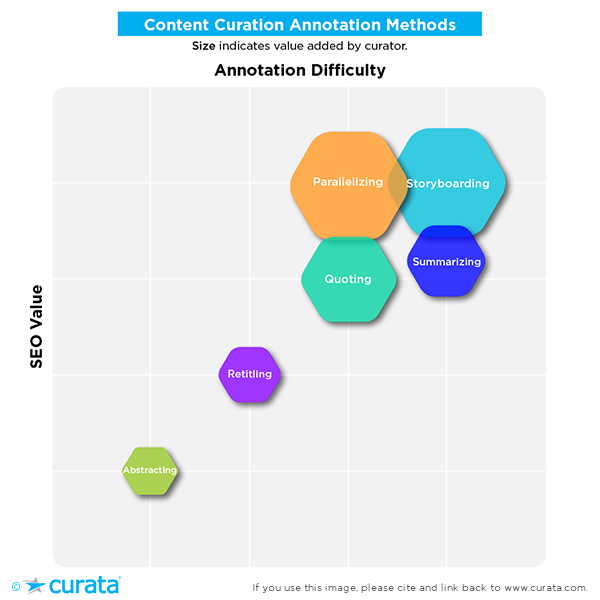- Share 6 Content Curation Templates for Content Annotation on Facebook
- Share 6 Content Curation Templates for Content Annotation on Twitter
- Share 6 Content Curation Templates for Content Annotation on Linkedin
- Share 6 Content Curation Templates for Content Annotation via email
Content curation should be an integral part of any content marketer’s strategy. It allows marketers to build thought leadership and credibility by presenting a diverse range of expert insights to your audience. It also ensures a regular publication schedule without the same investment original content creation requires.
Adding annotation and commentary to third-party content you choose to share is fundamental to quality content curation. It’s easy for novice curators to simply focus on finding and sharing relevant content while overlooking the importance of annotating content with your own perspective.
Why it’s Important to Annotate Curated Content

Annotating your content is crucial for a few reasons:
Differentiation
Curata’s Content Marketing Staffing & Tactics Planner shows content curation continues to accelerate in popularity year over year. This means others are curating the same content you are to their audience. Adding thoughtful commentary demonstrates your expertise and unique point of view about a subject to stand out from the rest. Thoughtful commentary is what separates a retweet bot from an emerging thought leader.
Search Engine Optimization (SEO)
With Google’s increased attention to duplicate content, curators must be mindful of how much content they excerpt from third-party articles. Excerpting a majority or large portion of an original article without proper link attribution risks Google penalizing your search ranking. However, by minimizing excerpts and affixing value-added commentary, Google will recognize a curated effort as original. Furthermore, your commentary enables you to incorporate other search keywords absent in the original article.
Fair Use and Ethics
When using other people’s content, be respectful of fair-use and copyright law. Kimberley Isbell of Harvard’s Nieman Journalism Lab emphasizes the importance of annotations and commentary. “Whenever possible,” advises Isbell, “Provide context or commentary for the material you use.” Read Curata’s Content Marketing Done Right eBook for a comprehensive exploration of the ethics of reusing other people’s work.
In many ways, annotations go back to the heart of curation in the physical world, predating online content curation. In museums, one of the primary functions of an art curator is not only to select which works of art to display and how to place them within the museum. It’s also to annotate art with narratives on “didactic labels” that describes the source and significance of the art.
Templates and Examples for Content Annotation
For demonstration purposes, let’s consider an article from the Atlantic Wire. It’s about a family who searched for “pressure cookers” on Google who were later visited by the police. In the rest of this post, I will describe templates and techniques to help annotate curated content. Here are some examples, along with the pluses and minuses of each technique.
As we dive into each technique, I’ve created this handy reference chart to help determine which annotation strategy is right for you.

Strategy 1: Abstracting
Many novice curators simply excerpt a portion of an original article by reposting the title, the first few sentences, and perhaps an image from the article, as shown below. Less ethically conscious curators may even unknowingly share a full-size image and lengthier excerpt. This puts them at risk of copyright infringement by sharing too much of the original content.
Now We Know Why Googling ‘Pressure Cookers’ Gets a Visit from Cops
Michele Catalano was looking for information online about pressure cookers. Her husband, in the same time frame, was Googling backpacks. Wednesday morning, six men from a joint terrorism task force showed up at their house to see if they were terrorists. Which prompts the question: How’d the government know what they were Googling?
Effort: LOW
You basically just cut and paste. Many content curation tools can do this for you.
SEO Value: LOW
You’re not at risk of duplicate content because you’re only sharing a small portion of text. But it doesn’t help you a whole lot either.
Value Add: LOW
You’re helping uncover and surface relevant content for your reader, but not providing much other value in terms of commentary or annotation.
Strategy 2: Summarizing
In this example, a curator writes a short synopsis of the article. While abstracting may also result in a summary of the article, the author is writing a completely new summary not found in the article.
Now We Know Why Googling ‘Pressure Cookers’ Gets a Visit from Cops
The Atlantic Wire reports on how a family received a visit from the police after searching on Google for ‘pressure cookers’ and later for ‘backpacks.’ In light of the Edward Snowden PRISM and XKeystore revelations, many suspect this is an outcome of the NSA’s PRISM program. What’s more disturbing according to the article, is that such searches are conducted a hundred times a week.
Effort: MEDIUM
The curator writes an original summary of the article.
SEO Value: HIGH
If done correctly, the abstract is all new, original content that can’t be found on any other page online. This is considered unique content for a search engine. Furthermore, it provides the opportunity to insert additional keywords.
Value Add: MEDIUM
For the end reader, the value add by the curator is moderate. The curator is helping to condense a larger article into a quick read, but it’s offering no new information or perspective on behalf of the curator.
Strategy 3: Quoting

Quoting is a popular method of annotating a third party article using the <blockquote> html tag commonly used on sites like Daring Fireball and Slashdot. A curator finds an interesting block of text from the article that doesn’t necessarily summarize it, but has an interesting perspective. Then they wrap their commentary around it. In many ways it’s similar to “pull quotes” you may have seen in print magazines that illustrate some provocative and interesting aspects of the larger article. Curata follows this practice on our curation industry blog, Content Curation Marketing.
Now We Know Why Googling ‘Pressure Cookers’ Gets a Visit from Cops
The Atlantic Wire reports on how a family received a visit from the police after searching on Google for ‘pressure cookers’ and later for ‘backpacks’. There’s a humorous explanation as to why they purchased a pressure cooker and the police’s line of questioning:
They were peppering my husband with questions. Where is he from? Where are his parents from? They asked about me, where was I, where do I work, where do my parents live. Do you have any bombs, they asked. Do you own a pressure cooker? My husband said no, but we have a rice cooker. Can you make a bomb with that? My husband said no, my wife uses it to make quinoa. What the hell is quinoa, they asked…
It’s scary to think of a world where an innocent online search can get you a visit from the cops. On the other hand, there is a legitimate concern that this behavior was reminiscent of the Boston Marathon bombings. Where do we draw the line between personal privacy and national security?
Effort: MEDIUM
The curator first has to read the article and find an interesting quote, then add their commentary around it.
SEO Value: HIGH
The value is relatively high because there’s a good deal of original commentary, but it’s mixed with a quote that came from another article.
Value Add: HIGH
Quoting is valuable for the reader because it lets them focus on just a key part of the article and quickly understand the curator’s point of view before reading the full article.
Strategy 4: Re-titling
With re-titling a curator simply creates a provocative title that expresses a point of view and may get a lot of click-throughs. It’s particularly effective if you’re sharing on social media. A great example of a content curation site that solely re-titles content for editorial spin is the Drudge Report. Re-titling can also be used in conjunction with other annotation techniques listed in this article, but sometimes may be enough by itself. It’s also very useful for mobile curation sites.
Where did the 4th Amendment go? Search on Google and get the cops at your doorsteps
Effort: LOW
All you do is change the title.
SEO Value: MEDIUM
By creating an original title, you can incorporate your own keywords and use curation to help your search ranking. At the same time, there’s very little content for search engines to index.
Value Add: LOW
The curator is adding little value because they have so little screen space to express their perspective.
Strategy 5: Storyboarding
A curator stitches together multiple pieces of content such as article abstracts, videos, tweets, and audio clips to tell a story interweaved with their own commentary. At the end you come up with a mash-up and narrative for a larger story. Here’s an example of one created about Google’s Moto X Smartphone.
Effort: HIGH
You have to outline your idea ahead of time. Then scour the web for multiple pieces of content, not just a single article. Then write a cohesive commentary.
SEO Value: HIGH
Storyboards are good clickbait and have the capacity to incorporate a lot of original keyword-rich text. However, sometimes embedded content such as javascript-based embeds and videos can’t always be indexed by search engines.
Value Add: HIGH
While heavily relying on other’s content, you are essentially creating new long form content with a lot of your perspective.
Strategy 6: Parallelizing
With parallelizing, a curator takes a piece of content seemingly unrelated to their topic of interest. They then write a summary explaining the significance of the third party content and how it relates to them and their audience. For example, imagine a Virtual Private Network (VPN) technology provider curates an article and relates it back to their business. (See example below.) It’s great for topics where there isn’t a lot of directly relevant content to begin with. Furthermore, it enables a curator to tie their point of view to a larger issue in the vein of “newsjacking.”
Why you should use a VPN tunnel for all your searches online
The Atlantic Wire reports on how a family received a visit from the police after searching on Google for ‘pressure cookers’ and later for ‘backpacks’. This highlights the growing need for stronger encryption of searches by setting your browser defaults to use HTTPS and SSL encrypted connections. Fortunately Google offers this, but many other search providers do not. Furthermore, Google does not by default load its search engine with HTTPS enabled, so most laypeople do not know it’s available.
With the increase in cases like this where an innocent family was harassed by the police based on their Internet search behavior, hopefully the general public will be more sensitive of the need for encryption. At the end of the day though, simple HTTPS does not suffice for most sites. The best approach is to use a dedicated VPN tunnel so all your traffic is encrypted and anonymized.
Effort: MEDIUM
Parallelizing is similar to summarization, where the curator is writing a new summary.
SEO Value: HIGH
This is high value because you can latch on to a larger story and newsjack those keywords. In this example, the curator tied VPNs to a larger story about Google searches and privacy, incorporating those words into their summary.
Value Add: HIGH
It’s high value because the curator is helping make an original connection with a seemingly unrelated article. It’s a unique point of view that’s unlikely to be found anywhere else, and can get visitors to keep coming back to you.
Annotation is Fundamental to Quality Content Curation
Now you’ve got the right technique for annotating curated content, I recommend you download Curata’s Curate Content Like a Boss eBook. It’s the ultimate hands on guide to effective content curation.















